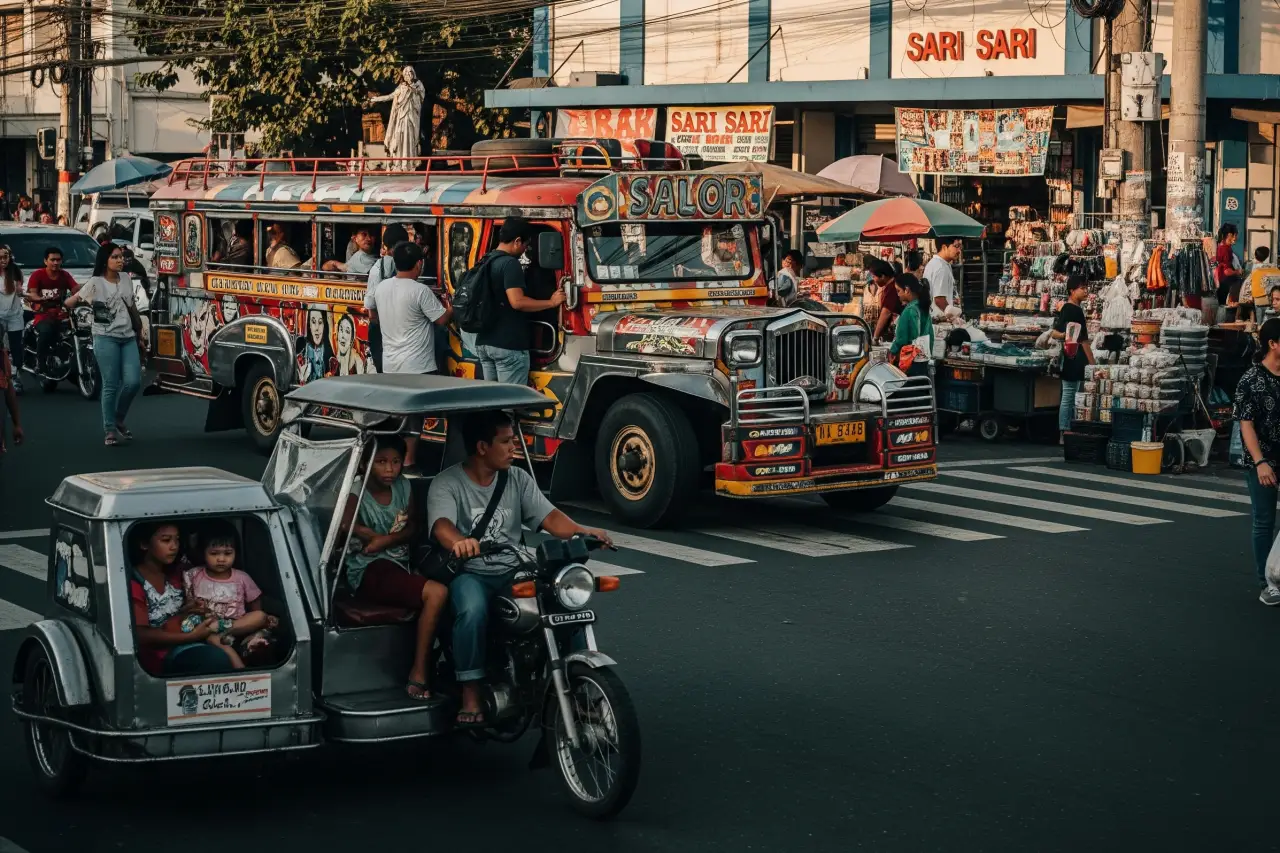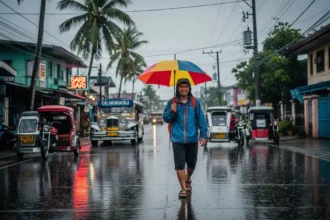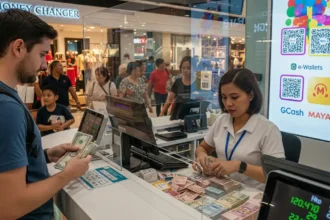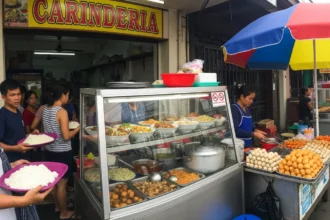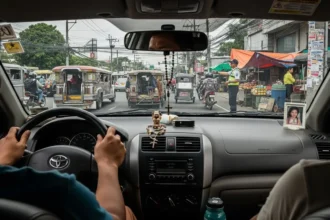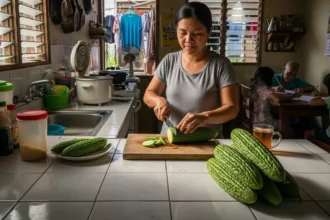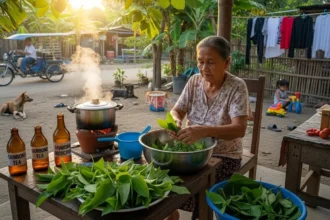If you’ve ever stood at the side of a busy Philippine road and watched jeepney & tricycle weave through traffic, you’ve probably wondered: “How on earth do I even ride one?” Don’t worry – you’re not alone. For first-time commuters, jeepneys and tricycles can feel like a mystery: handwritten signs, barkers shouting destinations, passengers handing coins in a chain, and people confidently saying “Para po!” at just the right moment.
- 🚍 Why Jeepneys and Tricycles Matter in the Philippines
- 🧭 First-Time Commuter Fears (and Why They’re Normal)
- 🪧 Understanding Jeepneys: Signs, Routes, and Terminals
- 🛺 Understanding Tricycles: When and How to Use Them
- 💵 Jeepney and Tricycle Fares in 2025
- 🤝 How to Pay the Fare (and Pass It Properly)
- ✋ Mastering the “Para!”
- 🎒 Safety Tips for First-Time Commuters
- 📱 Tech + Diskarte Hacks to Make Commuting Easier
- 🙌 Jeepney & Tricycle Etiquette (Commuter Manners 101)
- 🌍 For Tourists and Balikbayans: Extra Tips
- 📝 Quick Reference Tables
- ❓ Frequently Asked Questions
- ❤️ Final Say – Ride Like a Local with Confidence
This guide is here to take away the guesswork. Whether you’re a student new to the city, a balikbayan relearning local ways, or a tourist curious to ride like a true Pinoy, you’ll find everything you need here – from reading signboards and paying the correct fare, to mastering the all-important “para.” By the end, you won’t just survive your first ride – you’ll ride with confidence, diskarte, and a smile.
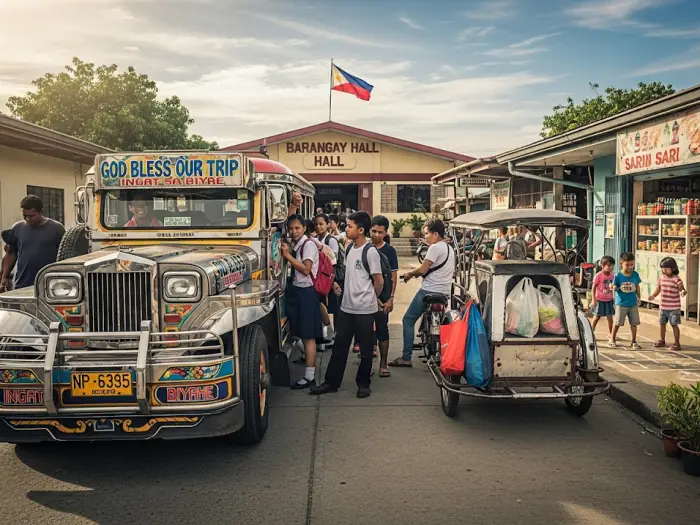
🚍 Why Jeepneys and Tricycles Matter in the Philippines
If you’ve ever asked a Filipino what the “real” way to experience the country is, chances are they’ll tell you to ride a jeepney or a tricycle at least once. These two humble vehicles are more than just transportation – they’re cultural icons, daily lifelines, and snapshots of Filipino life.
Jeepneys: The King of the Road
- Origins: Born from leftover U.S. military jeeps after World War II, Filipinos transformed them with elongated bodies, side-facing benches, and roofs that could carry both goods and people. Over time, they evolved into rolling canvases – painted with bright colors, religious sayings, pop culture images, and family names.
- Symbol of Filipino creativity: Jeepneys aren’t just practical, they’re art forms. Each one reflects the diskarte of its operator and the community it serves.
- Role in daily life: For millions of workers and students, jeepneys are the cheapest way to get to school, the palengke, or the office. They’re part of the morning grind and the after-work routine.
Tricycles: The Barangay Workhorse
- Hyperlocal transport: If jeepneys rule the main roads, tricycles dominate the inner streets and barangay corners.
- Adaptability: These motorcycles with sidecars can carry families, sacks of rice, school kids, even groceries from the market.
- Community link: Tricycles are usually regulated by the barangay or LGU, so routes are short but essential – especially in areas where jeepneys or buses can’t fit.
Why They Still Matter in 2025
Despite the rise of Grab, ride-hailing apps, buses, and trains in urban areas, jeepneys and tricycles remain:
- Affordable: Still the cheapest way to get around for the masa.
- Accessible: They reach areas that no other public transport can.
- Cultural: To ride them is to see and feel how everyday Filipinos live.
💡 In short, jeepneys and tricycles aren’t just vehicles – they’re a shared national experience. Whether you’re a first-time commuter, a balikbayan relearning the ropes, or a tourist curious about local life, knowing how to ride them connects you to the heart of the Philippines.
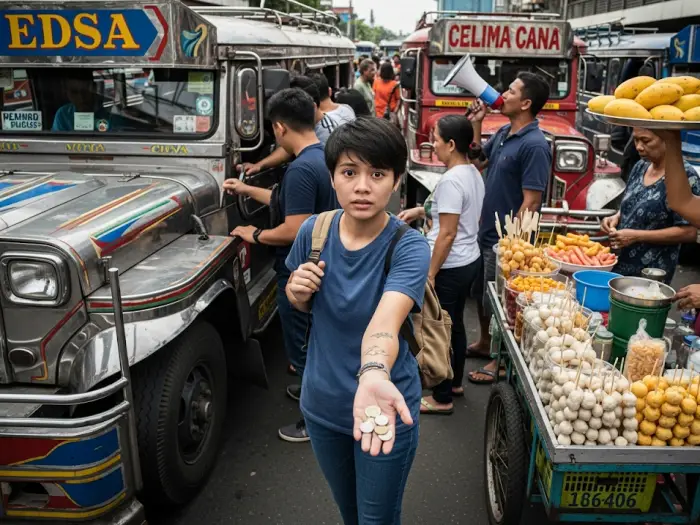
🧭 First-Time Commuter Fears (and Why They’re Normal)
If you’re about to take your very first jeepney or tricycle ride, it’s normal to feel a little nervous. In fact, even seasoned commuters can remember the first time they had to figure it all out. The good news? Every Pinoy has been in your shoes.
Common Fears of First-Timers
- “What if I miss my stop?”
Jeepneys don’t have digital screens or fancy “next stop” announcements. Most stops are landmark-based – malls, gas stations, churches, barangay halls. This can be intimidating if you’re unfamiliar with the route. - “How do I pay without embarrassing myself?”
The system of passing money, asking for change, or telling the driver your stop can feel confusing. Many first-timers worry about handing over the wrong amount or saying the wrong thing. - “What if people stare at me?”
Especially true for tourists, balikbayans, or younger Filipinos commuting for the first time. Don’t worry – most of the time, people are just curious, not judgmental. - “What if I look lost or clueless?”
It’s a very Pinoy instinct to blend in, but the truth is: commuters and drivers are usually more helpful than you’d expect.
Why These Fears Are Normal
- Jeepneys and tricycles don’t have standardized systems like trains or buses. The rules aren’t printed anywhere – they’re passed down by experience.
- The mix of Tagalog, Bisaya, or local dialects on signboards can add to the confusion.
- Payment etiquette (like saying “paki-abot po” or shouting “para po”) feels strange until you try it.
Reframing the Anxiety
Here’s the good news: every first-time ride is a confidence builder. Once you do it, you’ll realize it’s simpler than it looks. Think of it as learning a community rhythm – the gestures, the lingo, the diskarte. With just a few tries, you’ll find yourself doing it naturally.
💡 Pro Tip: If you ever feel unsure, don’t hesitate to ask fellow commuters. Filipinos are often more than willing to help first-timers, especially if you ask politely.
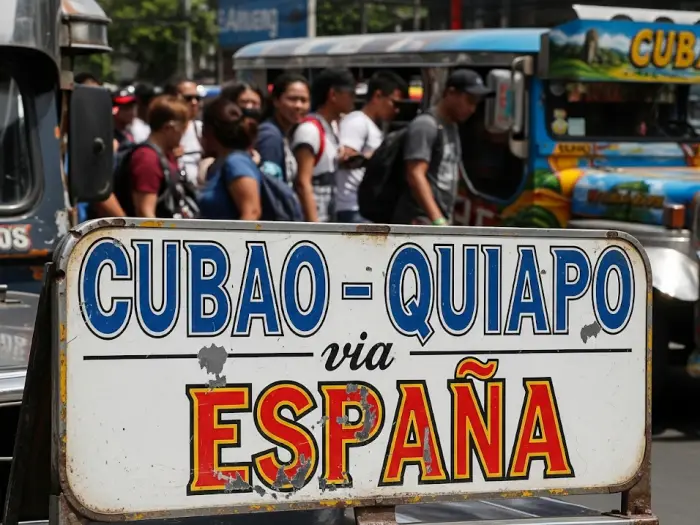
🪧 Understanding Jeepneys: Signs, Routes, and Terminals
For a first-timer, figuring out which jeepney to ride can feel like decoding a puzzle. Unlike buses or trains that follow strict stops, jeepneys rely on painted signboards, landmarks, and local knowledge. Once you learn how to read them, though, it’s surprisingly straightforward.
How to Read Jeepney Signboards
- Endpoints define the route. A jeepney with “Cubao – Quiapo” means it travels back and forth between those two places, passing through several landmarks in between.
- Abbreviations are common. Instead of full names, expect shortened versions like “Sta. Mesa” (for Santa Mesa), “D Tuazon” (for Don Tuazon Ave.), or “EDSA” (Epifanio de los Santos Ave.).
- Landmarks over street names. Jeepneys often highlight malls, markets, or churches instead of specific street addresses (e.g., “SM Fairview,” “Divisoria,” “Makati Ave.”).
- Directional hints. Some signboards include arrows or add-ons like “via Espana” to indicate which major road the jeepney takes.
💡 Pro tip: If you’re unsure about the exact route, ask the barker (the person calling passengers into the jeepney at terminals) or a fellow commuter. A simple “Dadaan po ba sa [landmark]?” works wonders.
Where to Find Jeepneys
- Terminals: Usually near big markets, malls, churches, or transport hubs. They often have barkers shouting destinations.
- Loading zones: In urban centers like Manila, designated areas are marked for jeepneys to pick up passengers.
- Roadside hailing: In provinces, you can often flag down a jeepney almost anywhere along its route, as long as it’s safe to stop.
Decoding the Chaos of Jeepney Stops
Unlike buses with fixed stops, jeepneys stop when you say “Para po.” But there are still common drop-off and pick-up points:
- Intersections and corners (kanto).
- Gas stations or convenience stores.
- Pedestrian-heavy spots like schools, barangay halls, and markets.
Color Coding and Local Variations
- In some cities (like Baguio or Cebu), jeepneys are color-coded by route.
- Provincial areas may have older models with handwritten signs instead of painted boards.
- Some routes display LTFRB-issued route numbers for official reference.
💡 The jeepney system may look chaotic, but it’s actually a well-oiled local network. Once you get the hang of the abbreviations and landmarks, you’ll find it’s the most affordable way to travel like a Filipino.
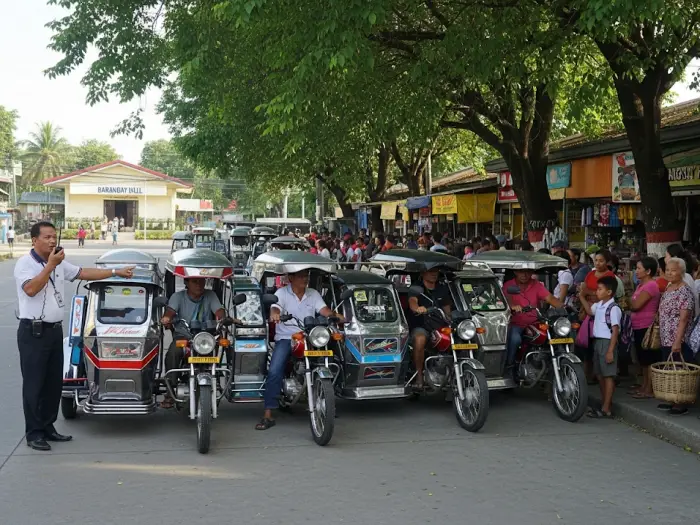
🛺 Understanding Tricycles: When and How to Use Them
If jeepneys are the kings of the main roads, tricycles are the barangay heroes. These small but mighty motorcycle–sidecar combos are everywhere, and for good reason: they can take you through the narrowest eskinita and drop you exactly where you need to go.
Where Tricycles Operate
- Barangay-focused transport: Tricycles usually operate within a town or barangay. Most LGUs (local government units) prohibit them from crossing highways or city borders.
- Neighborhood lifelines: In rural and suburban areas, tricycles connect residents to jeepney terminals, schools, palengkes, and health centers.
- Terminal system: You’ll find organized terminals near markets, barangay halls, malls, and transport hubs. Each terminal often has a fare chart posted.
Types of Tricycle Rides
- Regular/shared rides (pila system):
- You wait in line, pay per passenger, and share the ride with strangers.
- Cheapest option, but it may take longer since the driver drops off passengers one by one.
- Special rides (exclusive hire):
- You pay for the whole tricycle, regardless of how many passengers.
- More expensive but faster and more private.
- Useful when you’re carrying groceries, luggage, or traveling at night.
- Hybrid setups: Some areas have both systems, but always clarify with the driver or dispatcher.
How Fares Are Calculated
- Regular/shared: Usually ₱10–₱20 per passenger for short trips.
- Special hire: ₱40–₱100+ depending on distance, barangay rules, or terrain (hills, rough roads).
- Provincial vs. city difference: Provincial towns are generally cheaper, while urbanized areas (like Metro Manila or Davao City) can be pricier.
- Posted fare matrix: Terminals often have laminated tarps showing official rates – use these as reference to avoid being overcharged.
💡 Pro Tip: Always clarify before boarding – “Pila po ba ito o special?” This simple question saves you from fare misunderstandings.
Local Etiquette for Tricycles
- Shared ride courtesy: Don’t hog space if others are riding. Shift and adjust to fit everyone.
- Driver respect: Don’t argue about fares mid-ride. If unsure, ask about the rate before hopping in.
- Quick conversations: A simple “Sa tabi lang po” or “Dyan lang sa kanto” is the polite way to request a stop.
- Barangay rules: Some areas enforce seat limits (e.g., max 3 passengers). Follow them to avoid fines for the driver.
💡 Tricycles may not be glamorous, but they’re the backbone of community transport. For a first-timer, they’re the easiest way to practice local commuting – short routes, predictable fares, and lots of friendly drivers.
💵 Jeepney and Tricycle Fares in 2025
One of the biggest worries of first-time commuters is, “Magkano ba ang pamasahe?” Don’t worry – fares may vary slightly depending on location, but the basics are easy to understand once you know the system.
Jeepney Fares in 2025
- Minimum Fare: As of 2025, the standard minimum jeepney fare is around ₱13–15 for the first 4 kilometers, depending on city regulations and oil price adjustments.
- Distance-based Add-On: Beyond 4 km, expect an additional ₱1.50–₱2.00 per kilometer.
- Discounted Fares: Students, senior citizens, and PWDs usually get 20% off (bring ID to show proof).
- Regional Variations: Some provinces may have lower base fares, while Metro Manila usually has the highest.
💡 Pro Tip: Always carry coins (₱1, ₱5, ₱10) or small bills (₱20, ₱50). Jeepney drivers rarely have change for ₱500 or ₱1000.
Tricycle Fares in 2025
- Regular/Shared Rides: Usually ₱10–₱20 per passenger, depending on distance within the barangay.
- Special Hire (Exclusive Ride): Starts at ₱40 for short trips and can reach ₱100–₱150+ for longer or uphill routes.
- Provincial vs. Urban Rates:
- Provincial towns = cheaper, often ₱10 flat.
- Cities = higher, especially near malls or hospitals.
- Official Fare Matrix: Many tricycle terminals post laminated charts showing authorized rates. If unsure, politely ask: “Magkano po papunta sa [landmark]?”
What If You Don’t Have Exact Fare?
- Politely say: “Wala po akong barya, ₱50 lang.”
- Drivers usually try to give change, but sometimes they’ll ask if you have smaller bills.
- If change isn’t available, they may give sukli (coins) later when other passengers pay.
💡 Diskarte Tip: If you’re nervous about overpaying or getting confused with the fare, ask a fellow passenger before paying. Something as simple as “Magkano po papunta sa [place]?” will usually get you a helpful answer.
🤝 How to Pay the Fare (and Pass It Properly)
Paying the fare in a jeepney or tricycle isn’t complicated once you’ve seen it done a few times. But for first-timers, it can feel like a mystery: Where do I hand the money? Do I shout my stop? How do I get my change? Don’t worry – here’s the step-by-step diskarte.
Paying in Jeepneys
- Prepare Your Fare Early
- Have coins or small bills ready before you sit down.
- Avoid digging through your wallet when the jeep is already crowded.
- Say “Bayad po”
- Hand your fare to the nearest passenger between you and the driver.
- If you’re close to the driver, you can hand it directly.
- Ask for Sukli (Change) Properly
- Example: “Bayad po, Cubao lang, ₱20.”
- This tells the driver your destination and that you’re expecting change.
- Passing System
- Passengers are expected to help: if someone gives you money, you pass it forward until it reaches the driver.
- If you receive change, hand it back the same way.
- Common Lines to Use
- “Bayad po, [destination] lang.”
- “Paki-abot po.” (when asking others to pass your payment)
- “Pakisukli po sa ₱50.”
💡 Don’t worry – lahat tumutulong mag-abot. Even if you’re shy, people are used to this routine.
Paying in Tricycles
- Shared Ride: Hand your fare directly to the driver when you get off. No need to announce loudly.
- Special Hire: Confirm the price before the ride, then pay in full at the end.
- Change Matters: Like jeepneys, it’s best to use small bills. If you only have large bills, tell the driver at the start: “Wala po akong barya, ₱100 lang.”
Etiquette When Passing Fares
- Always say “Salamat” when handing money or change.
- Be careful not to drop coins or crumple bills – it slows things down.
- If the jeep is crowded, use short but polite words (“Bayad po,” “Sukli po”) instead of long explanations.
💡 Diskarte Tip: Observe first. If you’re unsure, watch how other passengers do it – you’ll quickly get the rhythm. Within a few rides, paying and passing will feel second nature.
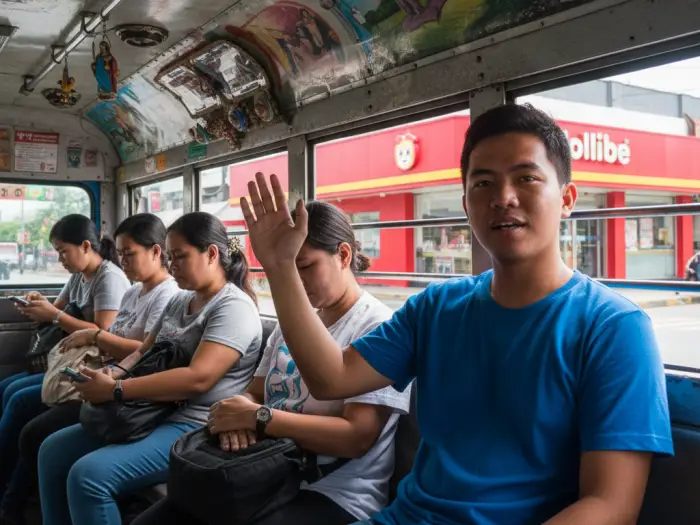
✋ Mastering the “Para!”
If there’s one commuter skill that every Filipino remembers nervously practicing, it’s saying “Para po!” – the magic phrase that tells the driver you want to get off. It may feel awkward at first, but with the right timing and confidence, you’ll be doing it like a pro in no time.
Timing Is Everything
- Say it early, not late. Don’t wait until the jeepney has already passed your stop – call out a few meters before your destination.
- Landmark-based stops. Since jeepneys don’t have official bus-style stops, use familiar spots like a Jollibee, gas station, or barangay hall as your reference.
- Evening rides. At night, call out a little earlier to give the driver time to safely pull over.
How to Signal Properly
- Verbal: The standard is to say “Para po” in a clear but polite voice. Add your landmark if needed:
- “Para po sa may 7-Eleven.”
- “Dyan lang po sa kanto.”
- Hand signal: Raise your hand slightly or tap the roof/handrail if the jeepney is noisy. Many commuters use a mix of voice + gesture to be sure.
- Tricycles: For trikes, simply say “Dito lang po” or tap lightly on the sidecar window when you’re near your stop.
What If You Miss Your Stop?
- Don’t panic. Just calmly call out “Para po, dito na lang” at the next safe corner.
- Walk back if needed – better safe than forcing the driver to stop in the middle of traffic.
- If you’re lost, politely ask the driver: “Pwede po bang makababa sa pinakamalapit na [landmark]?”
Pro Diskarte for First-Timers
- Observe other passengers. You’ll notice how they say “Para po” – short, confident, and clear.
- Don’t be shy. Drivers are used to passengers signaling stops every few minutes.
- Practice with a landmark. Before boarding, decide on a safe, clear landmark where you’ll get off so you don’t panic mid-ride.
💡 Remember: saying “Para po” is your way of joining the unspoken rhythm of Filipino commuting. Once you do it a few times, it’ll feel second nature.
🎒 Safety Tips for First-Time Commuters
For many Filipinos, commuting by jeepney and tricycle is perfectly safe – but like any form of public transport, it pays to stay alert. First-time commuters often worry about security, especially in busy city routes. Here are some practical tips para safe at sulit ang biyahe mo.
Secure Your Belongings
- Bags in front, not behind. Always hug your bag on your lap or sling it across your chest. Never leave it hanging on your back.
- Deep pockets for wallets. Avoid putting phones and wallets in back pockets. Pickpockets target these spots.
- Use small coin purses. Instead of flashing your whole wallet, prepare coins and small bills in a separate pouch for fares.
Choosing Your Seat Wisely
- Jeepneys:
- Sit near the middle if you want extra space and less exposure to snatchers near the entrance.
- If you’re commuting alone at night, avoid the back corners – these are harder for the driver to see.
- Tricycles:
- If alone, sit in the sidecar and avoid riding at the back of the motorcycle (reserved for quick hops in some areas).
- For women at night, ask to sit inside the sidecar, not beside the driver.
Stay Alert During the Ride
- Limit phone use inside. If you need to text, do it discreetly.
- Avoid wearing flashy jewelry or bringing out expensive gadgets.
- Keep an eye on your surroundings – trust your gut if something feels off.
Nighttime Commuting Tips
- For short distances, take a tricycle instead of walking through dark streets.
- Stick to well-lit loading zones or areas where other commuters are waiting.
- If it’s too late, consider Grab, Angkas, or taxis instead.
For Women and Solo Commuters
- Choose seats near other women if possible.
- Carry a whistle or small safety alarm in your bag.
- Share your live location with a family member or friend if commuting late.
💡 Diskarte Reminder: Most commuters ride jeepneys and tricycles daily without incident. Staying aware, polite, and prepared is usually enough to keep you safe.
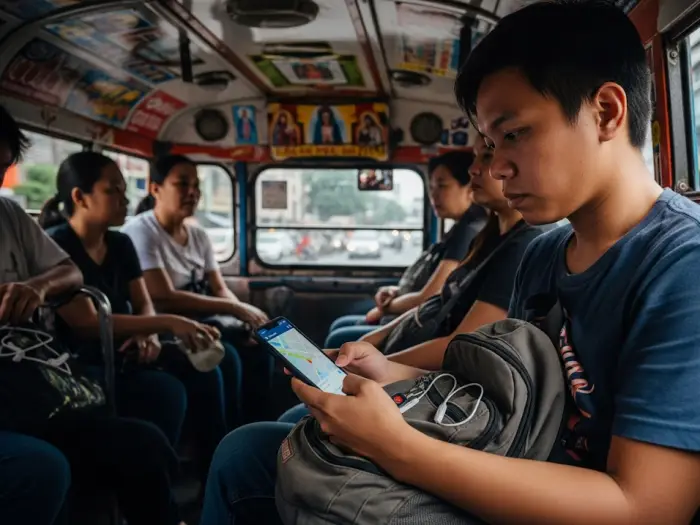
📱 Tech + Diskarte Hacks to Make Commuting Easier
Commuting may seem old-school, but thanks to apps and a few street-smart tricks, first-timers can ride jeepneys and tricycles with confidence. Here are some modern tools and classic diskarte moves to make your trip hassle-free.
Use Commuter Apps to Plan Your Route
- Google Maps:
- Shows approximate jeepney routes in Metro Manila and major cities.
- Use the “Directions” feature and choose the public transport icon.
- Sakay.ph (Metro Manila-focused):
- Lists jeepney, bus, and train combinations.
- Includes fare estimates – super helpful for budgeting.
- Moovit:
- Covers selected cities in the Philippines.
- Real-time updates and route alternatives.
💡 Diskarte Tip: Even if the app isn’t 100% accurate, it gives you a solid starting point. You can always confirm with locals.
Confirm Fares Before Riding
- For tricycles, especially special hires, ask: “Magkano po hanggang [landmark]?”
- Some tricycle terminals have posted fare charts, but not all do.
- If you’re a tourist or balikbayan, asking politely avoids misunderstandings.
Digital Payments (Emerging Trend)
- In some urban areas, a few jeepneys and tricycles now experiment with GCash or Maya QR codes.
- Still rare in provinces, so don’t rely solely on this. Always carry cash.
- Watch out for pilot projects announced by LGUs in big cities like Manila, Cebu, or Davao.
Commuter Diskarte Hacks
- Sit near the exit if you’re in a hurry. Saves time when you need to hop off quickly.
- Observe before acting. First-time riders can learn a lot just by watching how others pay or signal.
- Travel light. Avoid bulky bags or big shopping bags that make it hard to move around in a crowded jeep.
- Ask other passengers. Most Filipinos are friendly. A quick “Dadaan po ba ito sa [landmark]?” is normal and expected.
💡 Pro Reminder: Technology helps, but the real hack is Filipino pakikipagkapwa – don’t hesitate to ask for help. Chances are, someone will gladly guide you.
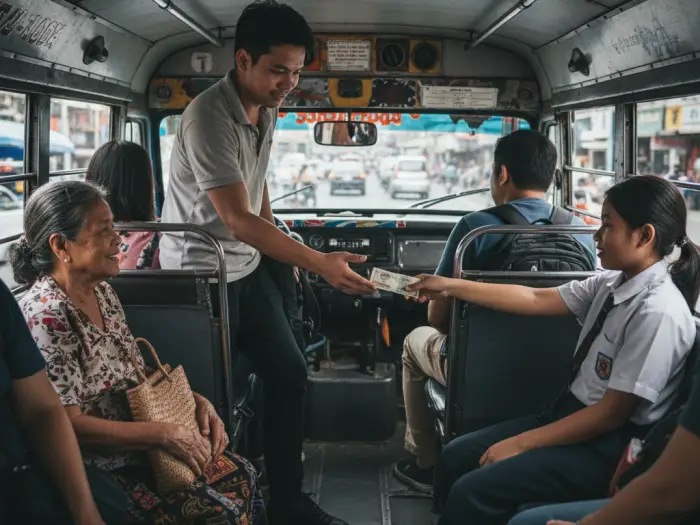
🙌 Jeepney & Tricycle Etiquette (Commuter Manners 101)
Every culture has its unspoken rules, and in the Philippines, jeepneys and tricycles come with their own set of commuter manners. Following these not only makes the ride smoother but also shows respect for fellow passengers and drivers.
Jeepney Etiquette
- Pass the fare promptly.
When someone says “Bayad po”, take the money and pass it forward without hesitation. It’s an unspoken trust system – everyone helps. - Don’t block the entrance.
If you’re seated near the door, scoot over so others can board or get off easily. - Priority seating.
Offer your spot to seniors, PWDs, pregnant women, and parents with small children. This isn’t just etiquette – it’s the law (Priority Seating Act). - Keep noise down.
Loud phone calls or blasting TikTok videos on speaker aren’t appreciated. Use earphones. - No smelly food inside.
Eating tuyo, shawarma, or anything pungent inside a cramped jeepney? Not a good idea. - Mind your space.
Sit properly and don’t spread your legs or bags – remember, space is tight.
Tricycle Etiquette
- Share the ride gracefully.
In a shared tricycle, adjust your seating so others can fit. Don’t act as if you “own” the space. - Confirm fare upfront.
Avoid awkward disputes by clarifying the price before you ride, especially for special hires. - Don’t overload.
Tricycles have limits – cramming 5–6 people makes the ride unsafe. Follow the barangay’s rules. - Be polite with stops.
A simple “Sa tabi lang po” is enough. Don’t shout or bang loudly unless necessary.
Universal Commuter Manners
- Greet or acknowledge the driver. A quick “Salamat po” when you get off goes a long way.
- Be patient. Jeepneys and tricycles stop often. If you’re in a rush, consider Grab or Angkas instead.
- Respect the driver’s hustle. These are people working long hours – avoid arguing over ₱1 or ₱2 if the fare is clearly posted.
💡 Diskarte Reminder: Etiquette isn’t about rules – it’s about pakikisama (getting along with others). Follow these simple habits, and you’ll blend right in.
🌍 For Tourists and Balikbayans: Extra Tips
Riding jeepneys and tricycles isn’t just about getting from point A to point B – it’s also about experiencing everyday Filipino life. If you’re a balikbayan rediscovering local commuting or a tourist trying it for the first time, these extra tips will make the experience smoother and more enjoyable.
Learn a Few Key Phrases
Even if you’re not fluent in Tagalog, knowing these basics will make a big difference:
- “Bayad po” – “Here’s my payment.”
- “Para po” – “Please stop here.”
- “Paki-abot po” – “Please pass this [money].”
- “Magkano po hanggang [landmark]?” – “How much to [landmark]?”
💡 Saying even just one of these makes you look less like a lost outsider and more like a respectful traveler.
Expect Curious Looks
- Foreign tourists often get friendly stares – don’t take it negatively. Many Filipinos are simply curious or amused seeing visitors trying out the local way.
- Smile back or nod – it breaks the ice. Sometimes, it even sparks small talk or helpful guidance.
When to Choose Grab, Taxi, or Angkas Instead
- Late at night. If it’s already midnight or later, Grab or taxi may be safer and more convenient.
- Long distances. Jeepneys and tricycles are best for short-to-medium trips.
- Heavy luggage. If you have suitcases or bulky bags, it’s better to get a car-based ride.
Why Locals Appreciate Tourists Riding Jeepneys & Tricycles
- It shows that you’re embracing the culture instead of sticking only to tourist modes of transport.
- Many Filipinos take pride in explaining routes and helping out foreigners or balikbayans.
- Plus, it’s one of the cheapest ways to stretch your budget – imagine paying less than a dollar for a ride across town.
💡 Diskarte Reminder: The key is respect. Learn the basics, go with the flow, and you’ll be surprised how many locals will go out of their way to make sure you’re safe and comfortable.
📝 Quick Reference Tables
1. Jeepney Fare Matrix (2025, Sample Estimate)
| Distance (km) | Regular Fare | Discounted Fare (Student/Senior/PWD) | Notes |
|---|---|---|---|
| 0 – 4 km | ₱13–₱15 | ₱10–₱12 | Minimum base fare varies by city |
| 5 – 6 km | ₱16–₱18 | ₱13–₱14 | Add ₱1.50–₱2.00 per km |
| 7 – 10 km | ₱20–₱24 | ₱16–₱19 | Check LTFRB matrix for updates |
| 11+ km | ₱25+ | ₱20+ | Long provincial routes may differ |
💡 Reminder: Always carry coins and small bills. Jeepney drivers rarely carry change for ₱500 or ₱1000.
2. Tricycle Fare Matrix (2025, Common Ranges)
| Type of Ride | Typical Fare | When to Expect It |
|---|---|---|
| Shared Ride (Regular) | ₱10 – ₱20 | Per passenger, within barangay |
| Special Hire (Short) | ₱40 – ₱60 | Exclusive ride for short distance |
| Special Hire (Long) | ₱80 – ₱120+ | Longer trips, uphill, or night rides |
| Provincial Rates | ₱10 flat | Cheaper, especially in rural towns |
| Urban Rates | ₱15 – ₱20 | Higher, especially near malls/markets |
💡 Diskarte Tip: Always clarify before boarding – “Special po ba o pila?”
3. Commuter Phrasebook – 10 Essential Lines
| Tagalog Phrase | English Meaning | When to Use |
|---|---|---|
| “Bayad po.” | Here’s my payment. | Handing fare |
| “Para po.” | Please stop here. | Signaling your stop |
| “Paki-abot po.” | Please pass this (money). | Asking others to pass fare |
| “Magkano po hanggang [landmark]?” | How much to [landmark]? | Confirming fare in tricycles |
| “Pakisukli po sa ₱50.” | Please give change for ₱50. | Requesting change |
| “Sa tabi lang po.” | Just by the side, please. | For precise stops |
| “Dadaan po ba sa [landmark]?” | Will this pass [landmark]? | Confirming jeepney route |
| “Saan po ang pila papuntang [place]?” | Where’s the line going to [place]? | Asking at terminals |
| “Salamat po.” | Thank you. | When paying or getting off |
| “Pwede po bang special?” | Can I hire this tricycle privately? | Negotiating special hire |
❓ Frequently Asked Questions
1. What if I don’t know where to get off?
You can ask the driver or fellow passengers: “Dadaan po ba sa [landmark]?” Then, watch for your landmark. If you miss it, just say “Para po, dito na lang” and walk back.
2. Do jeepneys and tricycles give exact change?
Yes, most do – but it’s always better to prepare coins or small bills. Don’t expect change for ₱500 or ₱1000.
3. Is it safe to ride at night?
Generally yes, but be cautious. Stick to well-lit areas, ride with other passengers when possible, and consider Grab or a taxi if it’s already very late.
4. Can I pay with large bills like ₱100 or ₱500?
Avoid it if you can. Drivers may not have enough change, especially at the start of their shift. Prepare smaller denominations.
5. How do I know if a tricycle is for special hire or shared ride?
If you’re at a terminal, ask: “Special po ba o pila?” A waiting line usually means shared rides, while empty trikes are often for hire.
6. What if I don’t speak Tagalog well?
No problem. A simple “Bayad po” and “Para po” will do. Many drivers understand English, especially in tourist areas. Gestures also help.
7. Are there discounts for students, seniors, and PWDs?
Yes, they get 20% off. Just present a valid ID if asked.
8. Do jeepneys and tricycles follow fixed stops?
Not like buses. Jeepneys and tricycles stop almost anywhere safe along the route – just signal with “Para po.”
9. What if I accidentally overpay?
Politely ask for change: “Pakisukli po.” If you realize it later, it’s usually too late, so it’s better to check right away.
10. Are kids allowed to ride jeepneys and tricycles?
Yes. Parents often bring children along. Small kids may sit on a parent’s lap, but for safety, hold them securely during the ride.

❤️ Final Say – Ride Like a Local with Confidence
The first time you step into a jeepney or climb into a tricycle, it might feel overwhelming – the signs, the shouting barkers, the coins being passed around, the mysterious timing of the “Para po!” But here’s the truth: you’ll get it faster than you think.
Every Filipino commuter once had the same worries you have now. The difference is, they just tried – and with each ride, they picked up the rhythm. Soon enough, you’ll also find yourself automatically handing exact fare, catching landmarks before your stop, and saying “Salamat po” as you hop off without even thinking.
Remember, jeepneys and tricycles aren’t just about getting from point A to point B. They’re about being part of the everyday life of millions of Filipinos – the morning rush, the student barkada rides, the late-night trike home after buying groceries. They connect communities, tell stories, and carry memories.
So don’t just ride to commute. Ride to experience, belong, and connect. With a little practice and diskarte, you won’t just survive commuting in the Philippines – you’ll thrive in it. And one day, you’ll laugh at how nervous you once were saying that first “Para po.”



